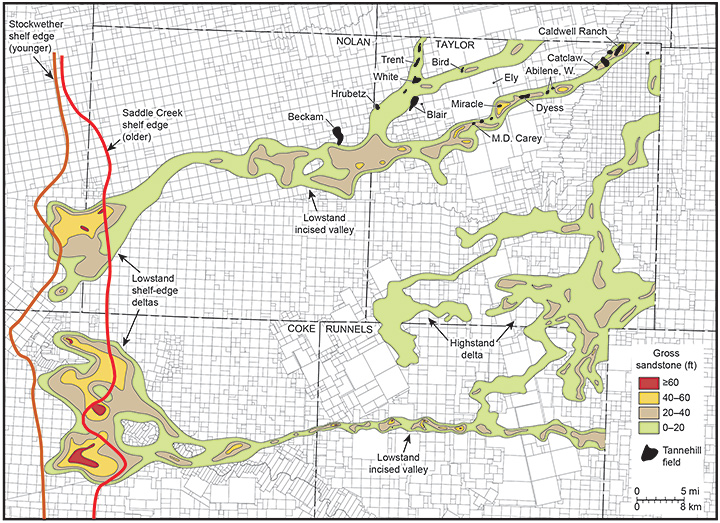
Incised-valley fill and highstand deltaic deposits and major oil and gas fields in the Tannehill Sandstone in Taylor, Nolan, Coke, and Runnels Counties. Modified from Hentz (2019).
STARR’s regional study of the Eastern Shelf of the Permian Basin will address the complex relationships that exist among Pennsylvanian stratigraphy, depositional systems, and tectonics and their controls on sediment-delivery systems and reservoir distribution in this mature and prolific region in the U. S. southern Midcontinent.
STARR is continuing its earlier regional study of the southern part of the Eastern Shelf, published previously in Bureau of Economic Geology Report of Investigations No. 282. In 2019, the STARR research team extended its scope of study to include a variety of stratigraphic intervals, including Cambrian sandstones, Ellenburger carbonates, the Bend Conglomerate, mixed Caddo carbonates and clastics in the Strawn Group, and younger units such as Canyon carbonates, deepwater slope sandstones in the Cisco Group, as well as incised-valley fill deposits of the Tannehill Sandstone of the Cisco Group.
In 2019, the STARR team presented aspects of its Eastern Shelf research at the annual meeting of the Southwest Section of AAPG in Irving, Texas. These presentations focused on lowstand, incised-valley fill systems in the Tannehill Sandstone in Nolan, Taylor, Runnels and Coke Counties, as well as a regional overview of outcrop to subsurface linkages in the Canyon and Cisco Groups.
For 2020, STARR is organizing a special symposium on the Eastern Shelf of the Permian Basin for the annual meeting of the South-Central Section of GSA in Fort Worth. Topics include (1) regional maps of deltaic deposits, relationships between coastal-shelfal tidal siliciclastic systems to ramp carbonates, and carbonate diagenesis in the Strawn Group, (2) autocyclicity in deepwater slope-channel systems and their controls on reservoir heterogeneity in Lake Trammel South field in the Cisco Group, and (3) relative controls of tectonics, basement structure, sediment supply, and eustasy on sediment-delivery systems in the Cisco Group.
Results of STARR’s Eastern Shelf research will lead to a better understanding of hydrocarbon reservoir distribution on both local and regional scales, providing an improved exploration framework for oil and gas operators in the Permian Basin, currently the most productive basin in the U.S.
Name of Project: Eastern Shelf Permian Basin Integrated Study
Name of Research Program: STARR-30
Date of project start: January, 2020
Term of project: January, 2022
Project PIs: William A. Ambrose and Tucker F. Hentz
Other key personnel: Peter Flaig, Chris Ogiesoba, Qilong Fu, Fritz Palacios, and Andrew Roberts
Principal information contact:
William A. Ambrose
william.ambrose@beg.utexas.edu
Tel: (512) 471-0258
Fax: (512) 471-0140
Funding source: State of Texas
Other key partners/collaborators: Burnett Oil Company, Tri Star Petroleum
Geographic area of study: Eastern Shelf of the Permian Basin, from Knox to Tom Green Counties (north to south)
General disciplines of study: Sequence stratigraphy, tectonics and sedimentation, source-to-sink characterization, provenance analysis, seismic inversion modeling, and reservoir diagenesis
Keywords (for search returns): Eastern Shelf of the Permian Basin, Paleozoic, Sequence stratigraphy, tectonics, and sedimentation, source-to-sink characterization